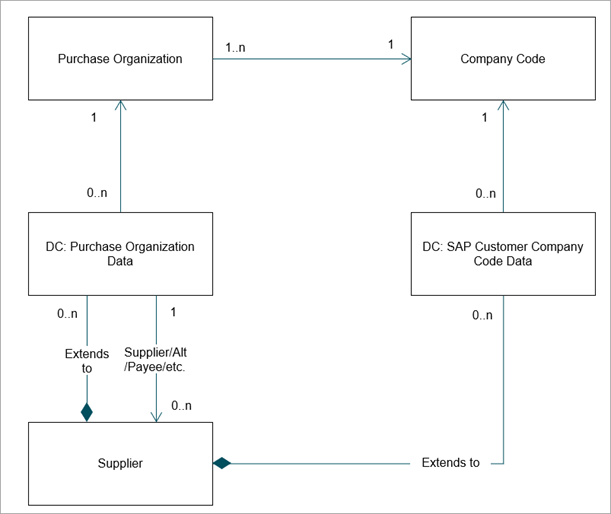This documentation assumes an understanding of generic SAP structures. The following logical model diagram shows an example of the data structure within SAP in a Customer MDM implementation.
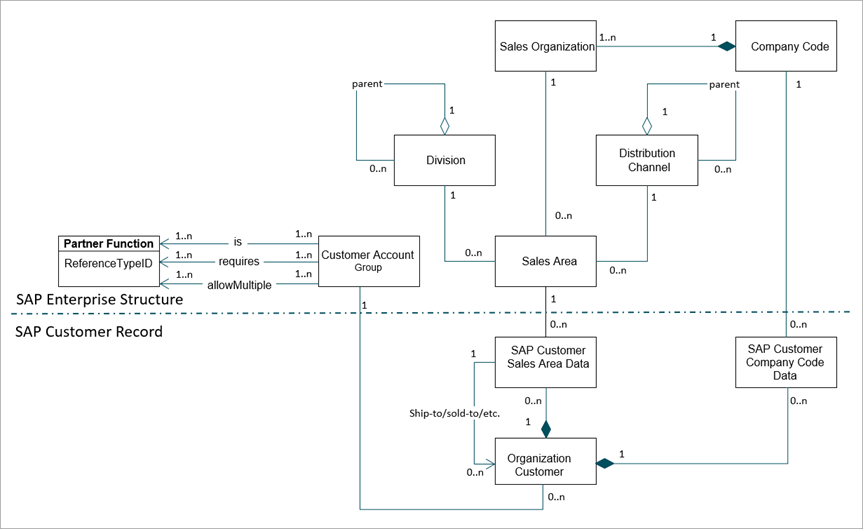
The following diagram shows an example of the data structure within SAP in a Supplier MDM implementation.
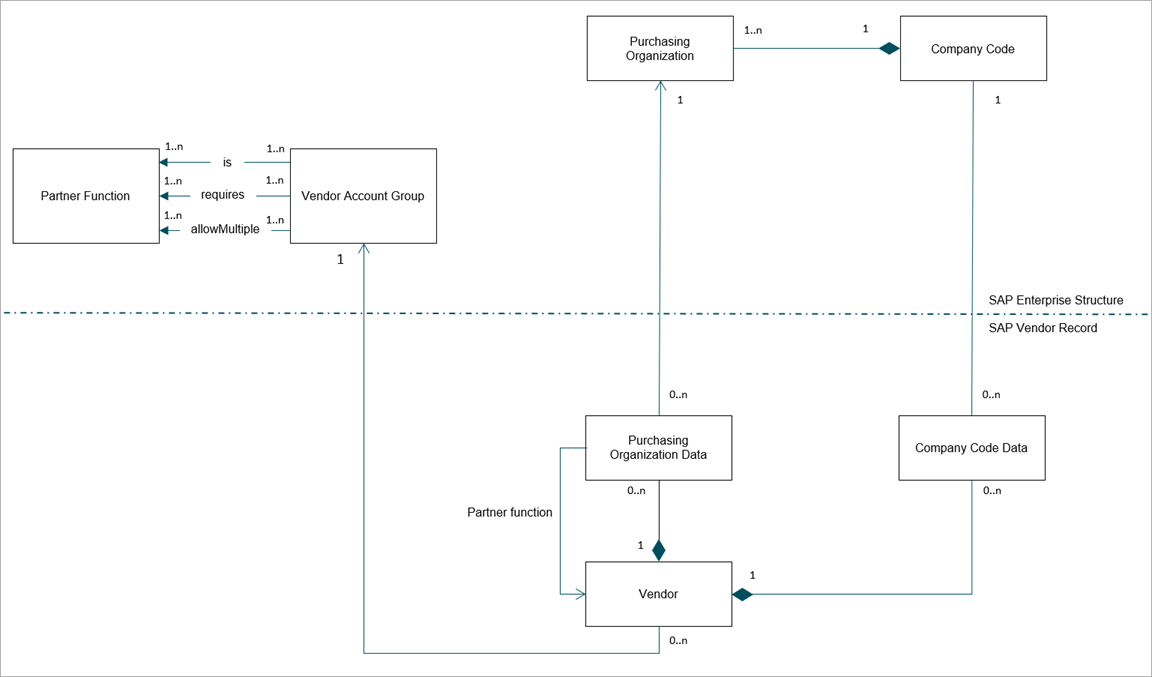
Because this topic uses SAP terminology, all readers are recommended to be familiar with these terms to better understand SAP data structures.
For the following terms, refer to the SAP Online Documentation for further details:
-
Company Code
-
Sales Organization
-
Distribution Channel
-
Division
-
Sales Area
-
Partner Functions
-
Account Group
-
Purchase Organization
For Partner Functions and Account Groups, refer to this SAP Online Documentation for further details:
SAP Customer and Supplier Data Constraints
The following sections expand on the logical model which details the relationships between entities and elements that include SAP customer, supplier, and enterprise structures.
Uniqueness Constraints
The following is a summary of the uniqueness constraints presented in the logical model diagram at the beginning of this topic:
-
The following types are unique by ID:
-
Customer Account Group
-
Vendor Account Group
-
Company Code
-
Sales Organization
-
Distribution Channel
-
Division
-
Customer
-
Supplier
-
Purchase Organization
-
Sales Area is unique by the combination of sales organization, distribution channel, and division.
-
Customer Sales Area Data is unique by customer and sales area.
-
Customer Company Code Data is unique by customer and company code.
-
Supplier Company Code Data is unique by supplier and company code.
-
Purchase Organization Data is unique by supplier and purchase organization.
Sales Area Constraints
A Sales Area defines the sales organization and distribution channel a division uses to sell products. Therefore, sales areas are comprised of distribution channel, division, and sales organization.
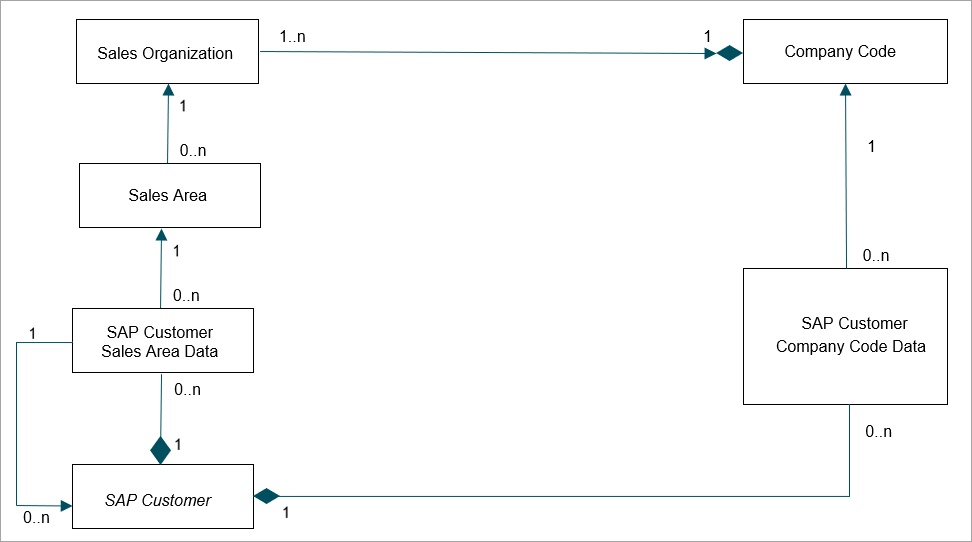
In STEP, sales areas are referenced from the SAP Customer object using a reference (ID= SAPCustomerSalesAreaDataSalesArea) from the Sales Area data container (ID= SAPCustomerSalesAreaData). A Business Partner (BP) may contain zero-to-many Sales Area data containers (ID=SAPCustomerSalesAreaData).
An SAP Customer may only have Sales Area Data if the corresponding Company Code Data is present such that the Sales Area must be associated to a Sales Organization that is associated to a Company Code for which the SAP Customer has Company Code Data.
Partner Functions Constraints
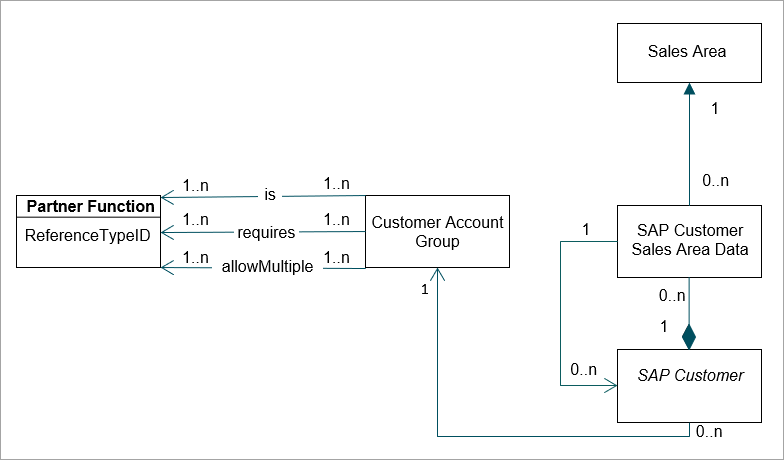
A Customer has exactly one Customer Account Group and a Supplier has exactly one Vendor Account Group. An account group has one-to-many valid partner functions. Not all customers and suppliers can act in all partner functions.
Since a Customer has a given account group, it must also have one or multiple Partner Function relations.
-
Valid Partner Functions - Not all customers or suppliers can act in all partner functions. The Account Group defines one-to-many valid Partner Function relations for a Customer / Supplier.
-
Mandatory Partner Functions - For each Sales Area Data or Purchasing Organization Data, the Account Group defines the required Partner Function relations for a Customer / Supplier.
-
Allow Multiple of a Partner Function - For each Sales Area Data or Purchasing Organization Data, the Account Group defines which Partner Function relations allow multiple Customers / Suppliers.
Common Distribution Channel and Division Constraints
To avoid redundant sales area master data across distribution channels and divisions, distribution channels and division may have a common 'parent,' which is logically resolved into what may be termed as 'common sales areas.' This concept means that sales areas associated with a particular distribution channel and division may have a common distribution channel and common division in another sales area within the same sales organization. This hierarchy is nested.
-
If a customer is active in a sales area that is common for other sales areas, this customer cannot have master data in the other sales areas.
-
If a customer is active in a sales area, a user is not allowed to activate that customer in the sales area's common sales areas.
Purchase Organization Constraints
A BP may contain zero-to-many Purchasing Organization Data Containers (ID=SAPPurchasingOrganizationData).
A BP may only have Purchase Organization Data if the corresponding Company Code Data is present such that the Purchase Organization (also called a 'purchasing organization') must be associated with a Company Code for which the Supplier has Company Code Data.
